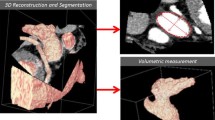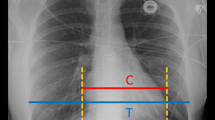Abstract
Objective
The purpose of this study is to describe a new method to quickly estimate left atrial enlargement (LAE) on Computed Tomography.
Methods
Left atrial (LA) volume was assessed with a 3D-threshold Hounsfield unit detection technique, including left atrial appendage and excluding pulmonary venous confluence, in 201 patients with ECG-gated 128-slice dual-source CT and indexed to body surface area. LA and vertebral axial diameter and area were measured at the bottom level of the right inferior pulmonary vein ostium. Ratio of LA diameter and surface on vertebra (LAVD and LAVA) were compared to LA volume. In accordance with the literature, a cutoff value of 78 ml/m2 was chosen for maximal normal LA volume.
Results
18% of LA was enlarged. The best cutoff values for LAE assessment were 2.5 for LAVD (AUC: 0.65; 95% CI: 0.58-0.73; sensitivity: 57%; specificity: 71%), and 3 for LAVA (AUC: 0.78; 95% CI: 0.72-0.84; sensitivity: 67%; specificity: 79%), with higher accuracy for LAVA (P=0.015). Inter-observer and intra-observer variability were either good or excellent for LAVD and LAVA (respective intraclass coefficients: 0.792 and 0.910; 0.912 and 0.937).
Conclusion
A left atrium area superior to three times the vertebral area indicates LAE with high specificity.
Key points
• Left atrial enlargement is a frequent condition associated with poor cardiac outcome.
• Left atrial enlargement is highly time-consuming to diagnose on CT.
• The left atrio-vertebral ratio quickly assesses left atrial enlargement.
• A left atrial area > three times vertebral area is highly specific.



Similar content being viewed by others
Abbreviations
- iLAESV :
-
Indexed to BSA left atrial end-systolic volume
- iLAMDV :
-
Indexed to BSA left atrial mid-diastolic volume
- LA:
-
Left atrium, left atrial
- LAA:
-
Left atrial area
- LAD:
-
Left atrial diameter
- LAE:
-
Left atrial enlargement
- LAESV :
-
Left atrial end-systolic volume
- LAMDV :
-
Left atrial mid-diastolic volume
- LAVA:
-
Left atrio-vertebral area ratio
- LAVD:
-
Left atrio-vertebral diameter ratio
- LAVR:
-
Left atrio-vertebral ratio
- VA:
-
Vertebral body area
- VD:
-
Vertebral body diameter
References
Tsang MYC, Barnes ME, Tsang TSM (2012) Left atrial volume: clinical value revisited. Curr Cardiol Rep 14:374–380
Abhayaratna WP, Seward JB, Appleton CP et al (2006) Left atrial size: physiologic determinants and clinical applications. J Am Coll Cardiol 47:2357–2363
Tops LF, Schalij MJ, Bax JJ (2010) Imaging and atrial fibrillation: the role of multimodality imaging in patient evaluation and management of atrial fibrillation. Eur Heart J 31:542–551
Mahabadi AA, Samy B, Seneviratne SK et al (2009) Quantitative Assessment of Left Atrial Volume by ECG-gated Contrast-enhanced Multidetector Computed Tomography. J Cardiovasc Comput Tomogr 3:80–87
Gweon HM, Kim SJ, Kim TH, Lee SM, Hong YJ, Rim S-J (2010) Evaluation of Left Atrial Volumes Using Multidetector Computed Tomography: Comparison with Echocardiography. Korean J Radiol 11:286–294
Sohrabi S, Hope M, Saloner D et al (2015) Left atrial transverse diameter on computed tomography angiography can accurately diagnose left atrial enlargement in patients with atrial fibrillation. J Thorac Imaging 30:214–217
Whitlock M, Garg A, Gelow J, Jacobson T, Broberg C (2010) Comparison of left and right atrial volume by echocardiography versus cardiac magnetic resonance imaging using the area-length method. Am J Cardiol 106:1345–1350
Ho SY, Sanchez-Quintana D, Cabrera JA, Anderson RH (1999) Anatomy of the left atrium: implications for radiofrequency ablation of atrial fibrillation. J Cardiovasc Electrophysiol 10:1525–1533
Hof I, Arbab-Zadeh A, Dong J, Scherr D, Chilukuri K, Calkins H (2008) Validation of a simplified method to determine left atrial volume by computed tomography in patients with atrial fibrillation. Am J Cardiol 102:1567–1570
Budoff MJ, Mao S, Wang S, Bakhsheshi H, Brundage BH (1999) Simple single-section method for measurement of left and right atrial volumes with electron-beam CT. Acad Radiol 6:481–486
Mosteller RD (1987) Simplified calculation of body-surface area. N Engl J Med 317:1098
Lin FY, Devereux RB, Roman MJ et al (2008) Cardiac chamber volumes, function, and mass as determined by 64-multidetector row computed tomography: mean values among healthy adults free of hypertension and obesity. JACC Cardiovasc Imaging 1:782–786
Gulati A, Ismail TF, Jabbour A et al (2013) Clinical utility and prognostic value of left atrial volume assessment by cardiovascular magnetic resonance in non-ischaemic dilated cardiomyopathy. Eur J Heart Fail 15:660–670
Christiaens L, Varroud-Vial N, Ardilouze P et al (2010) Real three-dimensional assessment of left atrial and left atrial appendage volumes by 64-slice spiral computed tomography in individuals with or without cardiovascular disease. Int J Cardiol 140:189–196
Baque-Juston M, Volondat M, Fontas E et al (2016) Left atrio-vertebral ratio: A new computed-tomography measurement to identify left atrial dilation. Eur J Radiol 85:255–260
To A, Flamm S, Marwick T, Klein A (2011) Clinical utility of multimodality LA imaging. JACC Cardiovasc Imaging 4:788–798
Truong QA, Bamberg F, Mahabadi AA et al (2011) Left atrial volume and index by multi-detector computed tomography: comprehensive analysis from predictors of enlargement to predictive value for acute coronary syndrome (ROMICAT study). Int J Cardiol 146:171–176
Walker JR, Abadi S, Solomonica A et al (2016) Left-sided cardiac chamber evaluation using single-phase mid-diastolic coronary computed tomography angiography: derivation of normal values and comparison with conventional end-diastolic and end-systolic phases. Eur Radiol 26:1–9
Stojanovska J, Cronin P, Patel S et al (2011) Reference normal absolute and indexed values from ECG-gated MDCT: left atrial volume, function, and diameter. AJR Am J Roentgenol 197:631–637
Geraghty EM, Boone JM (2003) Determination of height, weight, body mass index, and body surface area with a single abdominal CT image. Radiology 228:857–863
Lester SJ, Ryan EW, Schiller NB, Foster E (1999) Best method in clinical practice and in research studies to determine left atrial size. Am J Cardiol 84:829–832
Tseng W-YI, Liao T-Y, Wang J-L (2002) Normal systolic and diastolic functions of the left ventricle and left atrium by cine magnetic resonance imaging. J Cardiovasc Magn Reson Off J Soc Cardiovasc Magn Reson 4:443–457
Husmann L, Leschka S, Desbiolles L et al (2007) Coronary artery motion and cardiac phases: dependency on heart rate - implications for CT image reconstruction. Radiology 245:567–576
Jivraj K, Bedayat A, Sung YK et al (2016) Left Atrium Maximal Axial Cross-Sectional Area is a Specific Computed Tomographic Imaging Biomarker of World Health Organization Group 2 Pulmonary Hypertension. J Thorac Imaging 32:121–126
Bruzzi JF, Rémy-Jardin M, Delhaye D, Teisseire A, Khalil C, Rémy J (2006) When, why, and how to examine the heart during thoracic CT: Part 1, basic principles. AJR Am J Roentgenol 186:324–332
de Jong PA, Gondrie MJA, Buckens CFM et al (2011) Prediction of Cardiovascular Events by Using Non-Vascular Findings on Routine Chest CT. PLoS One 6:e26036
Choy G, Kröpil P, Scherer A et al (2013) Pertinent reportable incidental cardiac findings on chest CT without electrocardiography gating: review of 268 consecutive cases. Acta Radiol 54:396–400
Runge VM, Marquez H, Andreisek G, Valavanis A, Alkadhi H (2015) Recent technological advances in computed tomography and the clinical impact therein. Invest Radiol 50:119–127
Wagner M, Butler C, Rief M et al (2010) Comparison of non-gated vs. electrocardiogram-gated 64-detector-row computed tomography for integrated electroanatomic mapping in patients undergoing pulmonary vein isolation. Eur Eur Pacing, Arrhythmias, Card Electrophysiol J Work Groups Card Pacing, Arrhythmias, Card Cell Electrophysiol Eur Soc Cardiol 12:1090–1097
Huckleberry J, Haltom S, Issac T, Gabaldon J, Ketai L (2012) Accuracy of non-ECG-gated computed tomography angiography of the chest in assessment of left-sided cardiac chamber enlargement. J Thorac Imaging 27:354–358
Tsang TSM, Barnes ME, Gersh BJ, Bailey KR, Seward JB (2002) Left atrial volume as a morphophysiologic expression of left ventricular diastolic dysfunction and relation to cardiovascular risk burden. Am J Cardiol 90:1284–1289
Takemoto Y, Barnes ME, Seward JB et al (2005) Usefulness of left atrial volume in predicting first congestive heart failure in patients > or = 65 years of age with well-preserved left ventricular systolic function. Am J Cardiol 96:832–836
Gottdiener JS, Kitzman DW, Aurigemma GP, Arnold AM, Manolio TA (2006) Left atrial volume, geometry, and function in systolic and diastolic heart failure of persons > or =65 years of age (the cardiovascular health study). Am J Cardiol 97:83–89
Moller JE, Hillis GS, Oh JK et al (2003) Left atrial volume: a powerful predictor of survival after acute myocardial infarction. Circulation 107:2207–2212
Armstrong AC, Liu K, Lewis CE et al (2014) Left atrial dimension and traditional cardiovascular risk factors predict 20-year clinical cardiovascular events in young healthy adults: the CARDIA study. Eur Hear J Cardiovasc Imaging 15:893–899
Ristow B, Ali S, Whooley MA, Schiller NB (2008) Usefulness of Left Atrial Volume Index to Predict Heart Failure Hospitalization and Mortality in Ambulatory Patients With Coronary Heart Disease and Comparison to Left Ventricular Ejection Fraction (from the Heart and Soul Study). Am J Cardiol 102:70–76
Pritchett AM, Jacobsen SJ, Mahoney DW, Rodeheffer RJ, Bailey KR, Redfield MM (2003) Left atrial volume as an index of left atrial size: a population-based study. J Am Coll Cardiol 41:1036–1043
Tsang TS, Barnes ME, Bailey KR et al (2001) Left atrial volume: important risk marker of incident atrial fibrillation in 1655 older men and women. Mayo Clin Proc 76:467–475
Pritchett AM, Mahoney DW, Jacobsen SJ, Rodeheffer RJ, Karon BL, Redfield MM (2005) Diastolic dysfunction and left atrial volume: a population-based study. J Am Coll Cardiol 45:87–92
Thomas L, Levett K, Boyd A, Leung DYC, Schiller NB, Ross DL (2002) Compensatory changes in atrial volumes with normal aging: is atrial enlargement inevitable? J Am Coll Cardiol 40:1630–1635
Järvinen V, Kupari M, Hekali P, Poutanen VP (1994) Assessment of left atrial volumes and phasic function using cine magnetic resonance imaging in normal subjects. Am J Cardiol 73:1135–1138
Acknowledgements
We gratefully acknowledge the other investigators and the staff for their valuable contributions. We also wish to thank Jeffrey Arsham for reviewing our original English-language manuscript.
Funding
The authors state that this work has not received any funding.
Author information
Authors and Affiliations
Corresponding author
Ethics declarations
Guarantor
The scientific guarantor of this publication is Dr Baqué-Juston.
Conflict of interest
The authors of this manuscript declare no relationships with any companies, whose products or services may be related to the subject matter of the article.
Statistics and biometry
Dr Frédéric Berthier kindly provided statistical advice for this manuscript.
Informed consent
Written informed consent was waived by the Institutional Review Board.
Ethical approval
Institutional Review Board approval was not required because of the retrospective design of the study.
Methodology
• retrospective
• diagnostic study
• performed at one institution
Rights and permissions
About this article
Cite this article
Montillet, M., Baqué-Juston, M., Tasu, JP. et al. The Left Atrio-Vertebral Ratio: a new simple means for assessing left atrial enlargement on Computed Tomography. Eur Radiol 28, 1310–1317 (2018). https://doi.org/10.1007/s00330-017-5041-3
Received:
Revised:
Accepted:
Published:
Issue Date:
DOI: https://doi.org/10.1007/s00330-017-5041-3




